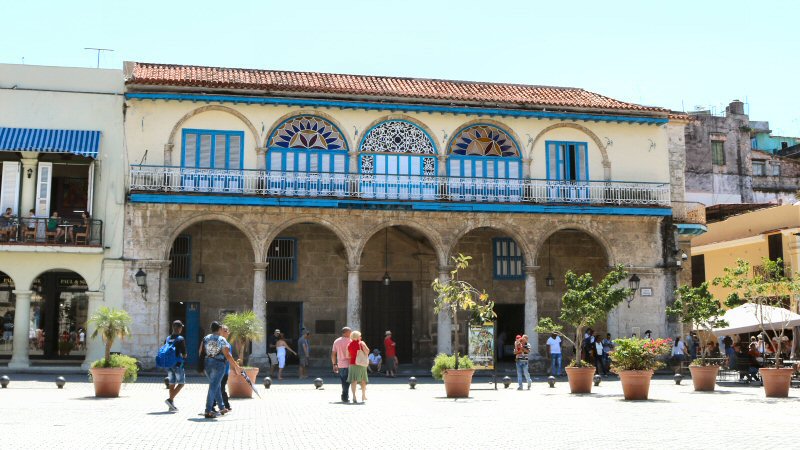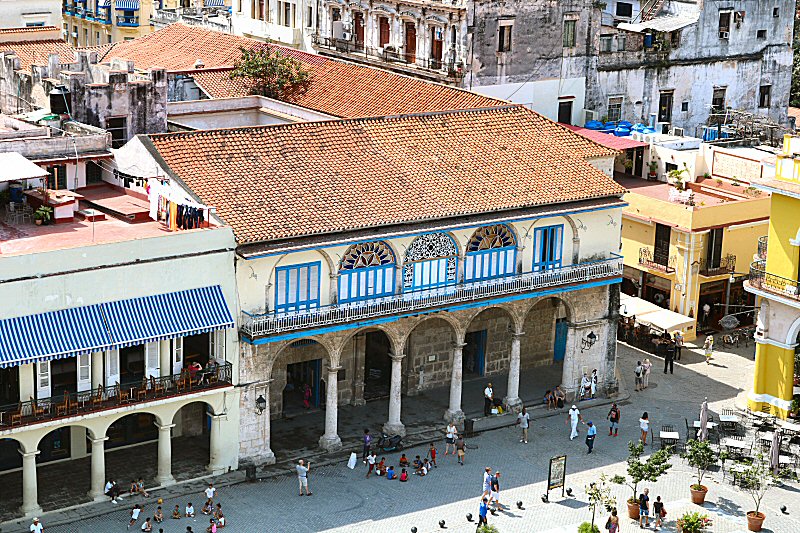
Palacio de los Condes de Jaruco
HISTORY
There was a small house like a hut, made of mortar and
tiles, at the place of the current Palacio de los Condes de
Jaruco in 1645. Antonia Aranda y
Avellanada that had inherited the property from his husband
José de Garro Bolívar y Armenteros, married later Gabriel
Beltrán de Santa Cruz y Valdespino. In 1732
they decided to build a small palace on this site and the
project was undertaken by the notable contractor Diego de
Salazar that had also carried out the construction of the
Havana walls.
When the construction was completed in
1738, they gave the house to their son Gabriel Beltrán de
Santa Cruz y Aranda, the first count of San Juan de Jaruco.
He received the title of Count of Jaruco in 1767 because of
his initiative and efforts of the founding of the town
Jaruco. The name of Jaruco comes from the indigenous word Axaruco that
means freshwater. He was born in Havana, and he was an
illustrious lawyer; lawyer of the Royal Councils of the
Monarch, Attorney of the Royal Treasury. He was
married with Doña Teresa Montalvo y O'Farrill, daughter of
the first Count of Casa Montalvo, and the granddaughter of
the first Count of Macuriges and the IV Marqués de Villalta.
She was also the progenitor of the Counts of Casa Bayona
that had a big colonial house in the Plaza de la Catedral.
After the death of the count the residence belonged to
different families.
The prestigious house, known as Palace of Santa Cruz
Beltrán at that time, entertained some notable personalities
of the time, such as Baron Alejandro de Humboldt. It was
also the birthplace of the notable writer and singer Doña
Mercedes de Santa Cruz y Montalvo, known as the Countess of
Merlin. By passage of time its indiscriminate use led to
deterioration and the house passed into oblivion. After a
long period of neglect, the house was completely restored as
part of the restoration of the Old City in 1983.
The
building owes its name to its first owner, the first Count
of San Juan de Jaruco, although the count actually lived
there for a short time. Nowadays the ground floor is devoted
to the art galleries Galería La Casona and Galería Roberto
Diago. Ranging from national to international and from
colonial to contemporary, there is always something for
every taste here. There is also a small souvenir shop Tienda
de Ediciones Artísticas. The building also houses the
headquarters of the Fondo de Bienes Culturales.
This
residence of aristocratic Creole families is a good example
where the Spanish mudejer and the baroque merge dexterously.
The building, typical of merchant houses of the era, is
constructed from local limestone. The two-level construction
with an intermediate mezzanine has a wide arcade, consisting
of four high columns that support semicircular arches. The
doors that open to the common balcony in the upper floor,
have stained glass in blue and white color. Through the
large gate and the hallway you can access the inner
courtyard with the garden. The rectangular patio is
surrounded with wide galleries that are connected with the
upper floor; a feature that is typical of Cuban colonial
house. The rooms are large and have mural paintings. The
carved wooden ceiling (alfarje), as well as the doors and
the balusters, are made of precious Cuban wood.

The Palacio de los Condes de Jaruco is
located on the Muralla street #111, where it intersects with the San
Ignacio street at the southwest corner of the Plaza Vieja.
